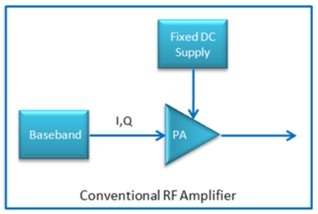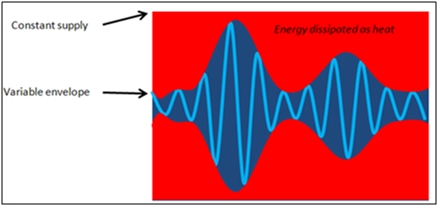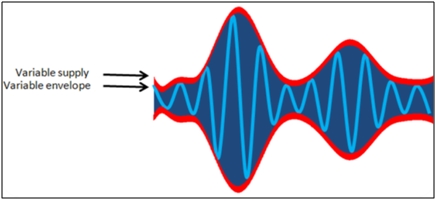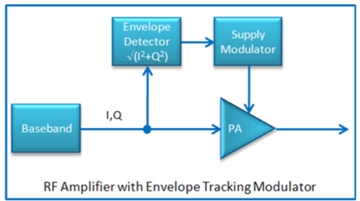Background
Envelope Tracking is a power supply technique used for improving the energy efficiency of Radio Frequency (RF) power amplifiers. Using this technique, the fixed DC supply voltage to the RF power amplifier is replaced with a dynamic supply voltage that closely tracks the amplitude or "envelope" of the transmitted RF signal. Envelope tracking ensures that the amplifier is operating at peak efficiency with respect to given output power requirements.
Requirement
Conventional RF amplifiers have a fixed supply voltage and operate most efficiently when the amplifier is in compression (that is, the output no longer increases linearly in response to an increase in input).

Figure 1: Conventional RF Amplifier
Next generation wireless systems such as 5G and WiFi6, use many OFDM carriers. As the number of carriers increase, so does the peak to average ratio (PAPR) of the signal, placing higher demands on the design of the amplifier stage.
As a result, however, the higher spectral efficiency leads to an increase in the peak-to-average power ratio (PAPR).
An amplifier operating with a fixed supply voltage becomes less efficient as PAPR increases because the amplifier spends more time operating below peak power and, therefore, spends more time operating below its maximum efficiency (with increased heat dissipation), as shown in Figure 2.

Figure 2: Reduced Efficiency in the Conventional RF Amplifier
In envelope tracking systems, the supply voltage is dynamically adjusted to track the RF envelope at high instantaneous power. Thus, the amplifier always operates in compression and therefore with high efficiency.

Figure 3: Improved Efficiency with Envelope Tracking
An envelope detector calculates the instantaneous amplitude of the transmitted signal and a supply modulator converts that amplitude signal into a supply voltage for the power amplifier. The supply voltage to the power amplifier continuously tracks the envelope of the transmitted signal and as a result, the amount of energy wasted through heat dissipation is minimized.

Figure 4: RF Amplifier with Envelope Tracking
Solution
Tabor Electronics’ Proteus family of Arbitrary Waveform Generators (AWGs) provides excellent support for envelope tracking applications. The Proteus RF Model, P9484 has four time aligned outputs allowing you to generate time aligned RF and baseband signals simultaneously. With easy connectivity the MATLAB, complex models of modulation and envelop can be easily created (See our GitHub page for an example)

Figure 5: Proteus AWG Support for Envelope Tracking
The Proteus family simplifies the measurement setup by having baseband and RF measurement capability in the same unit, saving cost and complexity by not having to integrate an AWG with a Vector Signal Generator. Proteus comes in three form-factors to match your exact need and cost point.

Envelope-Tracking Test Signal Generation with the Tabor Proteus AWT
For More Information
To learn more about Tabor’s solutions or to schedule a demo, please contact your local Tabor representative or email your request to [email protected]